Chongqing Huguang Guild Hall is located by the Yangtze River at Dongshuimen, Yuzhong District, Chongqing, lying along the Yangtze River at the eastern end of the Yuzhong Peninsula. It is one of the largest and best-preserved complex of guild hall buildings from the Ming and Qing dynasties in China, and a national 4A-level tourist attraction with a history of nearly 300 years. Featuring unique immigrant culture, exquisite ancient architectural craftsmanship and profound local cultural heritage, the scenic spot centrally showcases the migration, reproduction and cultural integration of immigrants from Huguang and other provinces in Chongqing during the Ming and Qing dynasties. The core area covers a land area of 18,418 square meters and a building area of 7,653 square meters.
History and Culture
The construction of Chongqing Huguang Guild Hall is closely linked to the famous "Huguang Migration to Sichuan" movement during the Ming and Qing dynasties. At the end of the Ming Dynasty and the beginning of the Qing Dynasty, Sichuan suffered a drastic population decline and vast barren land due to wars, plagues and other disasters. To restore production and stabilize the ruling order, the Qing government implemented a large-scale immigration policy starting from the Kangxi reign, organizing people from Hubei, Hunan, Guangdong, Guangxi, Jiangxi, Shaanxi and other provinces to migrate to Sichuan. This historical event is known as the "Huguang Migration to Sichuan". As immigrants gathered in Chongqing, those from different regions raised funds to build guild halls one after another for maintaining hometown ties, discussing affairs, and offering sacrifices to pray for blessings. Against this backdrop, Chongqing Huguang Guild Hall came into being.
The construction of the Huguang Guild Hall complex began in the 24th year of the Qianlong reign in the Qing Dynasty (1759 AD). After multiple expansions and renovations, it took shape as we see it today in the 26th year of the Daoguang reign in the Qing Dynasty (1846 AD). Initially built to serve immigrants from Huguang, the guild hall later gradually evolved into an important venue for cultural exchanges among immigrants from various provinces. Besides maintaining hometown bonds, the guild hall once served as a consultative body for the immigrant community to mediate disputes and organize commercial activities. It also functioned as a public space for worshipping deities such as Yu the Great and the God of Wealth, as well as hosting traditional opera performances, greatly promoting the integration of diverse regional cultures in Chongqing.
Since the 20th century, Huguang Guild Hall has suffered damage to some buildings due to the erosion of time and urban changes. In 1986, the Chongqing Municipal Government launched the first systematic renovation of the guild hall. In 2001, it was listed as a Major Historical and Cultural Site Protected at the National Level in the fifth batch. From 2003 to 2005, the relevant departments launched a large-scale emergency restoration project covering 6,400 square meters, restoring the main buildings and the historical style of the guild hall, which officially opened to the public in 2005. Today, it is not only a tourist attraction but also a significant memorial site of the "Huguang Migration to Sichuan" culture, attracting a large number of tourists and scholars every year to explore the traces of immigration history.
Major Attractions
Yuwang Palace
As the largest, earliest-built and most magnificent core hall in the complex of Chongqing Huguang Guild Hall, Yuwang Palace was first constructed during the Kangxi reign of the Qing Dynasty and served as a native-place guild hall built by immigrants from Huguang in Chongqing. It is not only the essence of guild hall architectural art but also a "spiritual palace" carrying the magnificent immigration history of the "Huguang Migration to Sichuan". The main deity enshrined in Yuwang Palace is Yu the Great, the great flood-control hero in ancient China. For immigrants who braved hardships to sail upstream along the Yangtze River from Hubei and Hunan to Bashu, Yu the Great was regarded as a protector who tamed floods and ensured the safety of boats and ships. Worshipping Yu the Great was not only a inheritance of their hometown culture but also a prayer for safe navigation on the perilous Yangtze waterway.

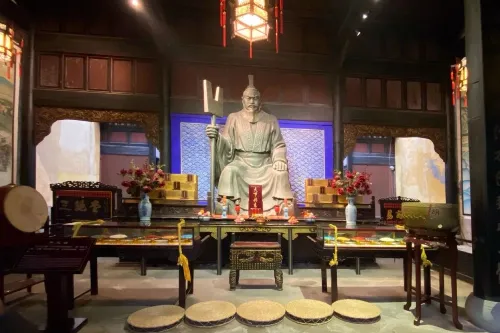
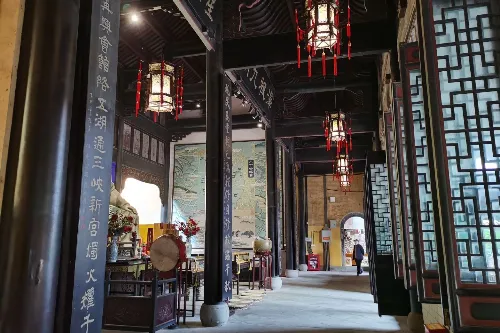
Guangdong Guild Hall
Adjacent to the west side of Yuwang Palace, Guangdong Guild Hall was built during the Jiaqing reign of the Qing Dynasty, covering a land area of approximately 900 square meters and a building area of about 800 square meters. Its architectural style combines features of Lingnan architecture and eastern Sichuan architecture. The main body of the guild hall is a two-story brick-and-wood structure. Its roof adopts the gable roof common in Lingnan areas, while integrating the column-and-tie frame structure of eastern Sichuan architecture, which not only adapts to Chongqing's climatic conditions but also reflects the integration of regional cultures. The most distinctive feature of the hall lies in its woodcarvings. The wooden pillars on both sides of the main gate are carved with auspicious patterns such as "pine and crane symbolizing longevity" and "magpie perching on plum blossoms". The woodcarvings on the crossbeams of the main hall depict scenes from "Romance of the Three Kingdoms", with vivid characters and coherent plots, which can be called masterpieces of woodcarving art. In addition, the brick-carved mountain gate of Guangdong Guild Hall is also highly distinctive. The brick-carved patterns above the gate are mainly composed of flowers and auspicious beasts, with rigorous composition and delicate carving, demonstrating the superb craftsmanship of Guangdong artisans.

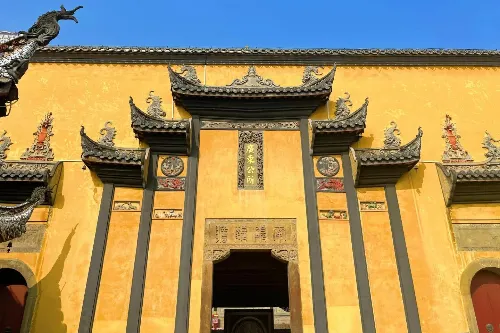
Qi'an Guild Hall
Located on the east side of Yuwang Palace, Qi'an Guild Hall was first built during the Jiaqing reign of the Qing Dynasty, covering a land area of about 850 square meters and a building area of around 700 square meters. It was constructed by immigrants from Huangzhou Prefecture in Hubei and got its name because Huangzhou was historically known as Qi'an. The opera stage of this building is its most prominent highlight. Facing north from the south, the stage is about 12 meters high, 10 meters wide and 8 meters deep. The stage floor is paved with blue flagstones, and the edge of the stage is carved with exquisite scroll patterns. The roof of the stage is a gable and hip roof, with a plaque inscribed with "Guande Building" hanging under the eaves. The wooden carved brackets on both sides are uniquely shaped into the pattern of "two lions playing with a ball". Historically, local Hubei operas such as Chu Opera were often performed here, making it not only an entertainment venue for immigrants but also an important carrier for spreading Hubei culture. In addition, the courtyard of Qi'an Guild Hall is exquisitely designed, with local tree species such as ficus virens planted inside, which set off the buildings and create a quiet and elegant atmosphere.
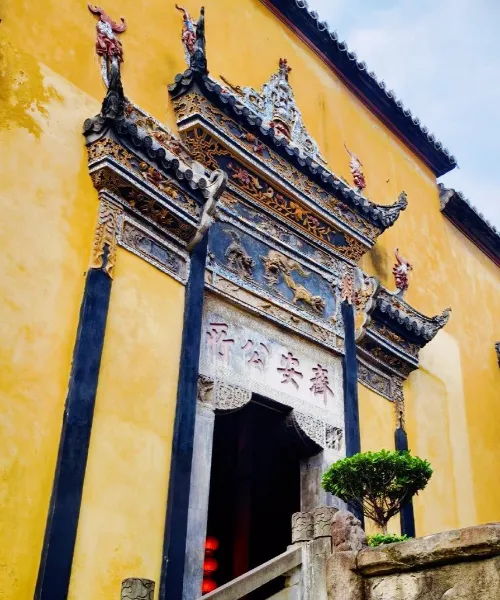

Immigration Museum
Located on the west side of Yuwang Palace, the Immigration Museum covers an area of about 600 square meters and is a thematic museum renovated from the auxiliary buildings of the guild hall. Through various forms such as text introductions, picture displays, physical exhibitions and scene restorations, the museum systematically presents the historical background of the "Huguang Migration to Sichuan", the course of immigration and the profound impact of immigrants on Chongqing's politics, economy, culture and other aspects. The museum collects more than 300 physical exhibits used by immigrants in the Qing Dynasty, including clay pots carried during migration, plows and harrows for farming, and contracts recording land transactions. In addition, the multimedia exhibition area in the museum restores the arduous scenes of immigration through video materials, allowing visitors to intuitively feel that magnificent period of immigration history.
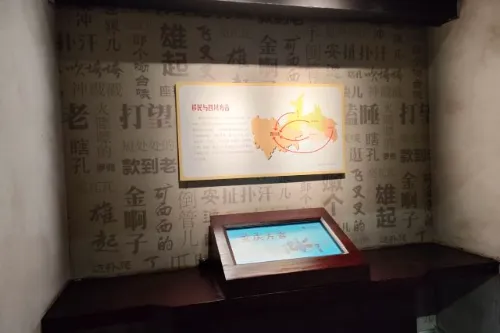

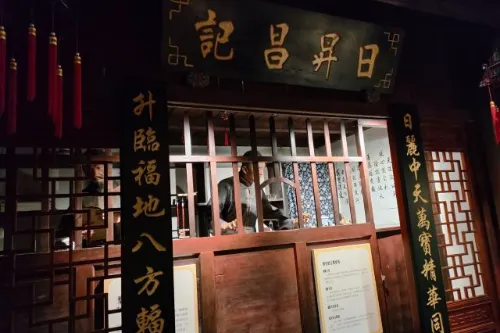
Recommended Tour Route
A recommended 2-hour boutique tour route, with a total walking distance of about 1.5 kilometers, is suitable for most visitors. After entering the scenic spot from the main gate, visitors first arrive at Yuwang Palace. Here, they can carefully appreciate the woodcarvings and brick carvings on the buildings, study the inscriptions in the hall, and learn about the core history and functions of the guild hall. After visiting the main hall, walk about 50 meters west to Guangdong Guild Hall, focusing on admiring its Lingnan-style woodcarvings and brick-carved mountain gate. Then walk about 100 meters east to Qi'an Guild Hall, stop to view the opera stage and imagine the lively scenes of traditional opera performances in the past. After visiting the core buildings, go to the Immigration Museum on the west side to systematically sort out the historical context of the "Huguang Migration to Sichuan" through exhibits and video materials. During the tour, visitors can take short breaks in the courtyards between the buildings and enjoy the beautiful scenery where the green plants in the courtyards set off the ancient buildings. It is recommended to slow down the pace throughout the tour to carefully appreciate the architectural details and cultural connotations.
Travel Tips
- Spring (March - May) and autumn (September - November) are the best seasons to visit, as the temperature in Chongqing is pleasant during these periods, with mostly sunny or cloudy weather. It is not only convenient for appreciating architectural details but also avoids the discomfort caused by extreme heat in summer and damp cold in winter.
- The buildings in the scenic spot have a long history, and some explanation contents involve complex immigration history and architectural knowledge. It is recommended to rent an electronic interpreter or hire a scenic spot guide to gain a deeper understanding of the cultural connotations of the scenic spot.
- The recommended tour duration is 1.5 to 2 hours. For those who are passionate about history, culture and architectural art, it is advisable to set aside about 3 hours to carefully view the carving craftsmanship and museum exhibits.
- There are cultural and creative stores in the scenic spot selling bookmarks, postcards and other cultural and creative products themed on immigration culture and ancient architectural carvings, which are suitable for purchasing as souvenirs.
- Traditional opera performances are held on the stage of Qi'an Guild Hall at 2 p.m. every Saturday, lasting about 40 minutes. Visitors can plan their time in advance to experience the charm of the integration of traditional operas and ancient buildings.
Notes
- All buildings in the scenic spot are Major Historical and Cultural Sites Protected at the National Level. Touching or carving on woodcarvings, stone carvings, brick carvings and other cultural relics is strictly prohibited, as is climbing the roofs, beams and columns of ancient buildings. Violators will bear corresponding legal responsibilities.
- Smoking is prohibited in the halls, and carrying fire sources into the scenic spot is strictly forbidden. There are multiple fire-fighting equipment and no-smoking signs in the scenic spot, which visitors must strictly abide by.
- Touching the physical exhibits in the Immigration Museum is prohibited. Do not use flash when taking photos to avoid damaging the exhibits.
- The passages in the scenic spot are relatively narrow, and there are many steps in some areas. The elderly and children must be accompanied when visiting, and pay attention to stepping safety to avoid falling.
- The scenic spot implements a traffic restriction policy. Visitors may need to queue up to enter during peak holiday periods. It is recommended to travel during off-peak hours and avoid the peak passenger flow from 10 a.m. to 2 p.m.
Transportation
- By Bus: Take buses No. 338, 375 or 376 and get off at Dongshuimen Bridge South Station. After getting off the bus, walk about 300 meters to reach the scenic spot entrance. Alternatively, take buses No. 414, 440 or 0491 and get off at Chuqimen Station, then walk about 500 meters to arrive.
- By Rail Transit: Take Chongqing Rail Transit Line 1 and get off at Xiaoshizi Station. Exit from Exit 5 and walk along Dongshuimen Main Street for about 1.2 kilometers, which takes about 15 minutes. Or take Line 6 to Xiaoshizi Station and transfer to Line 1, following the same route.
- By Self-driving: Departing from various districts in downtown Chongqing, you can reach the scenic spot via Dongshuimen Bridge, Yangtze River Bridge and other routes. There is a temporary parking lot near the scenic spot, located beside the Dongshuimen City Wall Ruins, with about 50 parking spaces. The charging standard is 10 yuan per trip for compact cars, with a parking time limit of 4 hours. For each additional hour beyond that, 2 yuan will be charged, and the maximum daily charge is 20 yuan.
- On Foot: If you are in the Jiefangbei business district of Yuzhong District, you can walk east along Linjiang Road for about 1.5 kilometers, enjoying the scenery along the Yangtze River on the way, and it takes about 20 minutes to reach the scenic spot.
Opening Hours
The scenic spot is open from 9:00 to 18:00 (ticket sales and admission stop at 17:00). The multimedia equipment in the museum operates from 9:30 to 12:30 and from 14:30 to 17:30 (subject to the actual situation of the scenic spot on that day).
Ticket Information
The ticket price is 32 yuan per person. You can search for the official WeChat service account "重庆湖广会馆" to get the latest updates or buy tickets online.
Online Booking
Click here to jump to the Trip.com ticketing platform for ticket purchase.